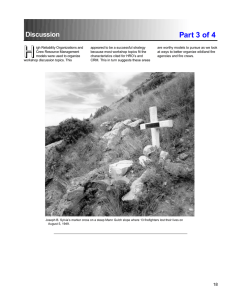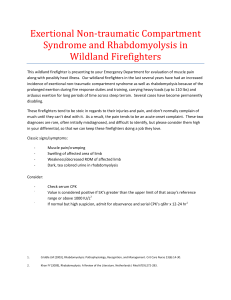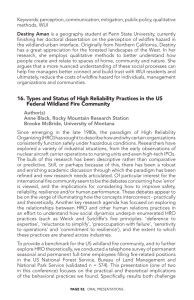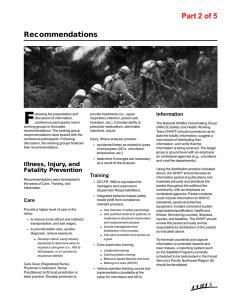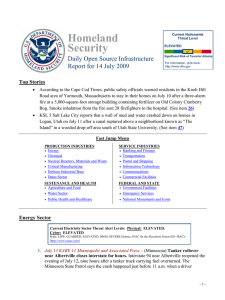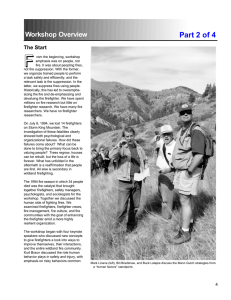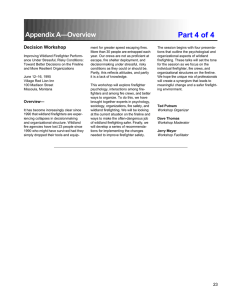H Part 3 of 4 Discussion
advertisement
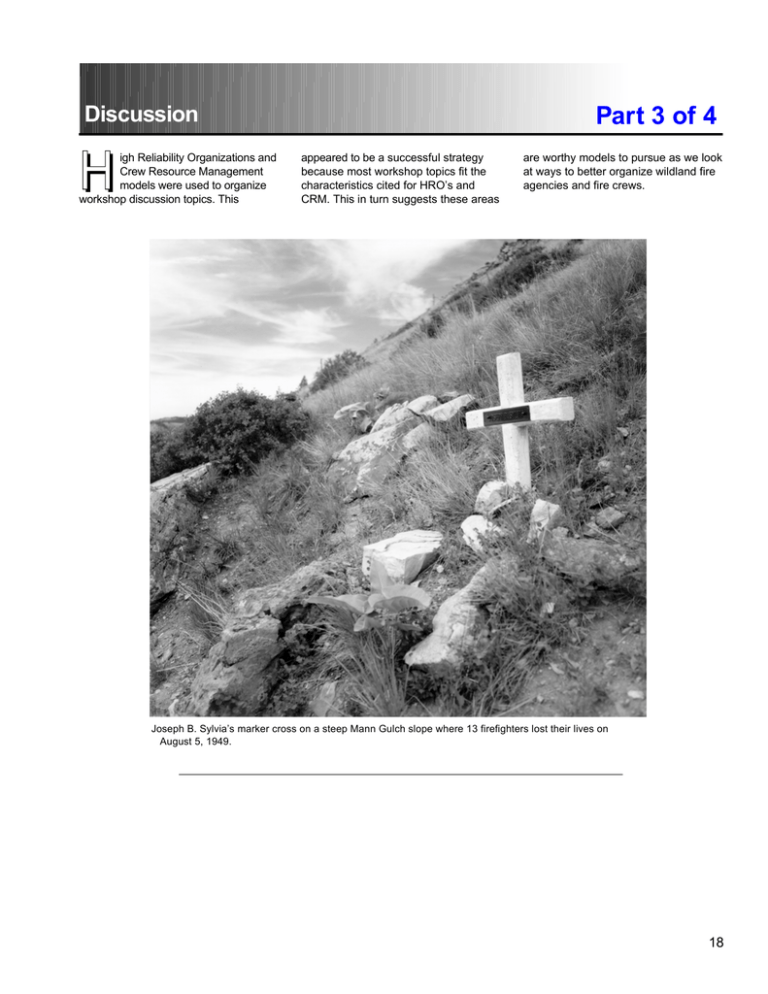
Discussion H igh Reliability Organizations and Crew Resource Management models were used to organize workshop discussion topics. This Part 3 of 4 appeared to be a successful strategy because most workshop topics fit the characteristics cited for HRO’s and CRM. This in turn suggests these areas are worthy models to pursue as we look at ways to better organize wildland fire agencies and fire crews. Joseph B. Sylvia’s marker cross on a steep Mann Gulch slope where 13 firefighters lost their lives on August 5, 1949. 18 Recommendations Part 3 of 4 ❖ Contract to have organizational experts evaluate Fire and Aviation Management (F&AM) and propose ways to reorganize it into a high reliability organization able to function at a high tempo during fire season. Evaluate F&AM using the seven factors presented earlier for effective HRO’s. Consider workshop input for organizational change when evaluating F&AM. ❖ Contract to have CRM course materials adapted to wildland fire crews and teams. Determine if other skills are necessary that are unique to the fireground environment. Consider workshop input when modifying CRM for firefighters. Change name to Fire Crew Dynamics and Fire Team Dynamics if course material would be different for firefighting crews and IMT’s. ❖ Study current loss of experienced firefighters, crew supervisors, FMO’s etc., to determine how to reverse these trends. Consider more FTE’s, higher pay, and other incentives. What is the effect of combining positions and collateral duties on the organization? ❖ Offer more incentives for seasonal firefighters to return and be better trained. Consider: • Bring them on earlier for extra training • Increasing bonus system for those returning for a third, fourth year, etc. • Pay for training costs incurred by firefighters in the off season when it is relevant, and they are returning another year, or give bonus in lieu of all costs. ❖ Contract to examine all the fire orders, situations, etc., to determine if they can be simplified and prioritized. Are any of them absolutes? Can what’s left be followed and still put out fires? Add management, crew, and internal watch-outs as needed. Workshop participants eat lunch on top of the ridge where Bob Sallee and Walt Rumsey escaped the Mann Gulch Fire. ❖ Red Card Qualification System does not work effectively. Contract to determine what the system is supposed to do and how to make it work. rapid awareness and decisionmaking by studying firefighters in their natural environment. ❖ Adopt common protocol and ❖ Study and formalize guidelines for engaging and disengaging from fire assignments. Study real crews and use content analysis and interview techniques such as Cognitive Task Analysis. language for all firefighting communications. Consider Campbell danger rating system for communicating vital fire information quickly and accurately. ❖ Develop leadership course(s) for all ❖ Initially develop decisionmaking examples suitable for wildland firefighters. Use firefighting examples to demonstrate how stress and other environmental and psychological factors affect decisions. To be effective, decisionmaking must be incorporated in all other training programs rather than, offered as a stand-alone course. ❖ Develop a situational awareness class and determine critical cues and how to accelerate training of inexperienced firefighters. Study the RPD model of IC’s and crew supervisors. Determine type of leadership needed on fireline and train people accordingly. ❖ Develop a family of “hot-seat” style fire simulators to train and evaluate CRM skills while in a high-tempo situation. A good developmental project could use the same inputs that allow computer modeling of an actual fire when relevant data is input. It can be used for training when inputs are chosen and firefighters must make a response. 19 Part 3 of 4 ❖ Conduct longitudinal study on fire crews to identify relevant behaviors that increase cohesion, safety, and productivity. Study whether management attitudes become crew attitudes. What factors and activities speed up the learning process? Are there sexual, racial, or age factors involved? ory transfer and learning, and is less boring than classroom-based training. ❖ Organize more national, regional, and local rendezvous where there is more mixing of type I, type II, engine, and helitack crews, FMO’s, IMT’s, and dispatchers so they can share knowledge and discuss problems. ❖ Require all prescribed burn plans to adopt a “classroom” element so the burn is fully utilized as a training exercise. ❖ Publish a human factors in wildland firefighting newsletter similar to Health Hazards of Smoke. ❖ Implement all assessment and feed- back proposals from the workshop. Without strong institutionalized baseline measurements and incident reporting, there is little chance to learn. ❖ Develop methods to speed up crew ❖ Hire professional instruction system designer to determine best format for implementing training, i.e., video, printed materials, computer simulation, etc., to maximize training transfer. Need to consider more hands-on, interactive training. Need more fieldbased training, which improves mem- cohesion and work practices before fireline assignments. ❖ The bulk of training occurs through OJT, but little preparation and care are given to make OJT work efficiently. Contract to study the best way to boost skills in a relatively short time with little cost through improved OJT. ❖ Contract to have professionals provide guidance in setting up procedures for collecting and disseminating lessons learned from fireline duties and entrapment that will be interesting and used by firefighters and managers. The above recommendations are not in any order of priority. The participants did not discuss priorities. In addition, even more recommendations could be pulled from the workshop notes. We felt that priority setting should have greater consensus than our group. In the mid1980’s, a number of conflicting equipment needs surfaced. To set priorities, more than 2,300 questionnaires were sent out to Forest Service and Interior Department offices and State agencies. Something similar is recommended here. We would like to encourage readers of these notes to suggest other recommendations, and we in turn will ask that NWCG consider surveying and prioritizing projects through input from the entire wildland fire community. 20 A Final Note Part 3 of 4 T he workshop findings and recommendations are not meant to be an end product but rather the beginning of a continuing assessment. It would be a mistake to think that a one-time effort to develop new training or a new organizational structure is enough. We hope to set in motion a process that will lead to a fire organization that reinvents itself as a high reliability organization where: ❖ The capacity to learn and adapt are valued and encouraged for the organization and the individual. ❖ The people are committed to the principles of CRM on the fireground. ❖ Safety and firefighters are number one. Suggested reading, see page 23. 21 Part 3 of 4 References Creed, Douglas; Stout, Suzanne; Roberts, Kathlene. 1993. Organizational effectiveness as a theoretical foundation for research on reliabilityenhancing organizations. In: Roberts, Kathlene H., ed. New challenges to understanding organizations. New York: Macmillan Publishing Co.: 63-70. Ensely, Pam. 1995. Historical wildland fire-fighter fatalities 1910-1993. NFES #1849. Boise, ID: National Wildfire Coordinating Group, Safety and Health Working Team, National Interagency Fire Center. Frantz, T.M. [and others]. 1990. The identification of aircrew coordination skills. In: Proceedings of the 12th annual Department of Defense symposium. Colorado Springs, CO: U.S. Air Force Academy: 97-101. Kanki, Barbara; Palmer, Mark. Communication and crew resource management. 1993. In: Wiener, Earl; Kanki, Barbara; Helmreich, Robert, ed., Cockpit resource management. San Diego: Academic Press, Inc.: 99-136. Koch, Barbl A. 1993. Differentiating reliability seeking organizations from other organizations: development and validation of an assessment device. In: Roberts, Kathlene H., ed. New challenges to understanding organizations. New York: Macmillan Publishing Co.: 81. Prince, Carolyn; Salas, Eduardo. 1993. Training and research for teamwork in the military aircrew. In: Wiener, Earl; Kanki, Barbara; Helmreich, Robert, ed., Cockpit resource management. San Diego: Academic Press, Inc.: 337-366. Rochlin, Gene I. 1993. Defining ‘high reliability’ organizations in practice: a taxonomic prologue. In: Roberts, Kathlene H., ed. New challenges to understanding organizations. New York: Macmillan Publishing Co.: 15. Weick, Karl E. 1995. Sensemaking in organizations. Thousand Oaks, CA: Sage Publications. -End Part 3- 22
